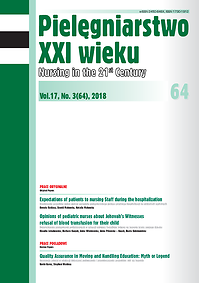Stopień uzależnienia od Internetu w grupie uczniów szkół gimnazjalnych i licealnych
DOI:
https://doi.org/10.2478/pielxxiw-2018-0022Słowa kluczowe:
uzależnienie, Internet, młodzież szkolnaAbstrakt
STOPIEŃ UZALEŻNIENIA OD INTERNETU W GRUPIE UCZNIÓW SZKÓŁ GIMNAZJALNYCH I LICEALNYCH
Wprowadzenie. Rozwój mass mediów, w tym Internetu znacząco wpłynął na styl życia współczesnej młodzieży. Pomimo powszechnego dostępu oraz niezliczonych możliwości jakie daje Internet, coraz częstszym zjawiskiem obserwowanym od kilku lat jest nadmierne korzystanie z sieci przez młodzież, które może prowadzić do uzależnienia od Internetu.
Cel pracy. Celem niniejszej pracy było określenie stopnia uzależnienia od Internetu w grupie uczniów szkół gimnazjalnych i licealnych oraz wybranych uwarunkowań tego stanu.
Materiał i metody. W pracy posłużono się metodą sondażu diagnostycznego z wykorzystaniem techniki ankiety. Kwestionariusz pytań zawierał standaryzowany test Kimberly Young oraz ankietę własnego autorstwa. Badania przeprowadzono na grupie 263 uczniów szkół gimnazjalnych i licealnych, w okresie od kwietnia do czerwca 2018r.
Wyniki. Wśród badanych uczniów u blisko 11% stwierdzono uzależnienie od Internetu. Najczęstszym celem wykorzystywania Internetu przez ankietowanych było korzystanie z serwisów społecznościowych (95%). Dolegliwościami zdrowotnymi związanymi z długim czasem korzystania z sieci u uczniów uzależnionych było ogólne przemęczenie i niewyspanie (61%). Osoby uzależnione od Internetu znacznie częściej czuły się samotne (61%), przygnębione, zdenerwowane lub smutne 78,6% (n=22) w porównaniu z grupą pozostałych badanych.
Wnioski. Zmienne demograficzne nie mają znaczącego wpływu na rozwój uzależnienia od Internetu. Funkcjonowanie psychospołeczne wpływa na rozwój uzależnienia od Internetu.
Bibliografia
1. Makaruk K. Korzystanie z portali społecznościowych przez młodzież. Wyniki badania EU NET ADB. Dziecko krzywdzone. Teoria, badania, praktyka. 2013; 12(1): 69-79.
2. Morbitzer J. O istocie medialności młodego pokolenia. Neodedigmata. 2011-2012; 33/34: 132-153.
3. Pawłowska B, Pabis B. Czynniki osobowościowe i rodzinne w uzależnieniu młodzieży od Internetu: opis przypadku. Postępy Psychiatrii i Neurologii. 2007; 1(21): 65-71.
4. Komunikat z badań CBOS. Pracoholicy, siecioholicy, hazardziści… Uzależnienia od zachowań. Nr 76/2015. Warszawa; 2015.
5. Pawłowska B. Potembska E. Uzależnienie od Internetu u uczniów szkół średnich w kontekście czynników rodzinnych. Family Medicine & Primary Care Review. 2011; 13: 226-228.
6. Pawłowska B, Potembska E. Objawy zagrożenia i uzależnienia od Internetu mierzonego Kwestionariuszem do Badania Uzależnienia od Internetu, autorstwa Pawłowskiej i Potembskiej u młodzieży polskiej w wieku od 13 do 24 lat. Current Problems of Psychiatry. 2011; 12(4): 439-442.
7. Białokoz-Kalinowska I, i wsp. Internet addiction (netaholics) in the secondary school adolescents – impact on the health and psychosocial skills. Pediatria i Medycyna Rodzinna. 2011; 7(4): 372-377.
8. Dębska G, i wsp. Problem używania Internetu przez młodzież. [w:] Zagrożenia zdrowotne wśród dzieci i młodzieży. T. 3. (red.) Seń M, Dębska G. Kraków: Oficyna Wydawnicza AFM; 2011, s. 125-137.
9. Toranto F, i wsp. Zespół uzależnienia od Internetu w grupie 402 uczniów szkoły średniej. Psychiatria Polska. 2015; 49: 255- 263.
10. Caban R, i wsp. Internet and the effects on family relationships. [w:] Internet – szanse i zagrożenia. (red.) Czarnecki E, i wsp. Płock: Wydawnictwo Państwowej Wyższej Szkoły Zawodowej w Płocku; 2011, s. 105-109.
11. Chwaszcz J, i wsp. Media. Uzależnienia, fakty i mity. Lublin: Gaudium; 2005.
12. Fundacja Dzieci Niczyje: Nadmierne korzystanie z komputera i Internetu przez dzieci i młodzież. Warszawa: Polskie Centrum Programu Safer Internet; 2012.
13. Jakubik A. Zespół uzależnienia od Internetu. Studia Psychologica. 2002; 3: 133-142.
14. Jarczyńska J, Orzechowska A. Siecioholizm i fonoholizm zagrożeniem współczesnej młodzieży. [w:] Uzależnienia behawioralne i zachowania problemowe młodzieży. (red.) Jarczyńska J. Bydgoszcz: Wydawnictwo Uniwersytetu Kazimierza Wielkiego; 2014, s.121-146.
15. Kaliszewska K. Nadmierne używanie Internetu. Poznań: Wydawnictwo Naukowe UAM; 2007.
16. Makaruk K, Wójcik S. Nadużywanie internetu przez młodzież. Wyniki badania EU NET ADB. Dziecko krzywdzone. Teoria, badania, praktyka. 2013;12(1): 35-48.
17. Janocha A, Klimatskaya LG. Internet Addiction Disorder in pupils and students of Krasnoyarsk (Russia) and Wrocław (Poland). Hygeia Public Health. 2011; 46(4): 449-452.
Opublikowane
Numer
Dział
Licencja
Prawa autorskie (c) 2018 Autorzy

Praca jest udostępniana na licencji Creative Commons Attribution-NonCommercial-NoDerivatives 3.0 Unported License.




